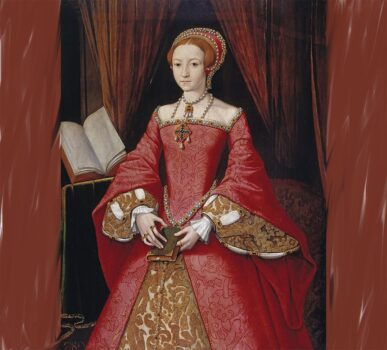Elizabeth I’s Forbidden Romances: The Men Who Captivated the Virgin Queen
Elizabeth I of England, known to history as the Virgin Queen, is one of the most fascinating monarchs the world has ever known. Her reign, lasting from 1558 to 1603, marked a golden age of exploration, literature, and national identity for England. Yet, beyond her political brilliance, Elizabeth’s private life has always been shrouded in mystery, speculation, and intrigue. Who were her lovers? Why did she never marry? How did she command a nation as a woman in a male-dominated world? Let’s dive deep into the enigmatic story of Elizabeth I, uncovering facts, myths, and the secrets that made her one of history’s greatest rulers.
Elizabeth was born on 7 September 1533, the daughter of King Henry VIII and his second wife, Anne Boleyn. Her birth was initially a disappointment to her father, who desperately wanted a male heir. Her mother’s downfall was equally tragic, Anne Boleyn was executed when Elizabeth was just two and a half years old. Declared illegitimate and removed from the line of succession, Elizabeth’s early years were filled with uncertainty.
But Elizabeth inherited her mother’s intelligence, wit, and determination, and her father’s commanding presence and ambition. She was given a first-class humanist education, mastering Latin, French, Italian, Greek, and even dabbling in Spanish. Her love of learning would later become one of her hallmarks as queen.
The Road to the Throne
Elizabeth’s path to power was never straightforward. She lived under constant suspicion during the reign of her half-sister Mary I, also known as “Bloody Mary.” When Mary married Philip II of Spain and executed Protestants by the hundreds, Elizabeth, a Protestant herself, was seen as a potential rival. At one point, she was even imprisoned in the Tower of London, accused of involvement in rebellion.
But Elizabeth survived. When Mary died in November 1558, Elizabeth ascended the throne at the age of 25. England was in turmoil, politically divided, financially strained, and facing threats from powerful Catholic nations abroad. Many doubted that a young, unmarried woman could lead. Yet, Elizabeth proved them wrong.
The Virgin Queen: A Life Without Marriage
One of the most enduring mysteries of Elizabeth I’s life was her decision never to marry. In an age when queens were expected to wed and produce heirs, Elizabeth’s refusal was both shocking and revolutionary. She cultivated the image of herself as the Virgin Queen, wedded to her country.
But why? Historians have debated this for centuries, and several theories emerge:
Trauma from Her Parents’ Marriage
Elizabeth saw firsthand the dangers of royal marriage. Her mother had been executed. Her father went through six wives. Marriage for Elizabeth was not just personal, it was a political minefield.Fear of Losing Power
Any husband she chose, whether English or foreign, would wield enormous influence, threatening her independence as queen. By remaining single, Elizabeth kept her power entirely her own.Political Strategy
Elizabeth used the possibility of marriage as a diplomatic weapon. She entertained proposals from kings and princes across Europe but never followed through, keeping them guessing and England safe.
Elizabeth’s Lovers: Mystery or Reality?
Although she never married, Elizabeth was rarely free from rumors of love affairs. Court whispers, ambassadors’ reports, and later romanticized histories all suggest that Elizabeth had close relationships with several men. Whether these were true romances, deep friendships, or purely political alliances remains part of her mystery.
1. Robert Dudley, Earl of Leicester
The most famous of Elizabeth’s companions was Robert Dudley, her childhood friend and lifelong favorite. When Elizabeth became queen, Dudley was often at her side, sparking intense speculation. Scandal erupted when Dudley’s wife, Amy Robsart, died suddenly in 1560 from a fall down the stairs. Many whispered that Dudley had arranged her death to free himself to marry Elizabeth. Though nothing was proven, the shadow of suspicion ensured Elizabeth could never marry him without risking her throne.
Yet their bond remained unbreakable. Elizabeth once called him her “Eyes.” When Dudley died in 1588, she reportedly locked herself away in grief.
2. Sir Walter Raleigh
Explorer, soldier, and poet, Sir Walter Raleigh dazzled Elizabeth with his wit and daring. He was part of her circle of adventurers who expanded England’s influence across the seas. Though some claim Elizabeth had romantic feelings for him, their relationship soured when Raleigh secretly married one of her ladies-in-waiting, Bess Throckmorton, without permission. Furious, Elizabeth had them both imprisoned in the Tower.
3. Robert Devereux, Earl of Essex
Another dramatic figure in Elizabeth’s later life was Robert Devereux, the dashing Earl of Essex. Almost thirty years younger than Elizabeth, Essex became her new favorite at court. Their relationship was fiery, full of affection, jealousy, and betrayal. When Essex led a failed rebellion against her in 1601, Elizabeth had no choice but to order his execution. The queen’s devastation afterward was profound; some accounts say she never truly recovered from his death.
4. Foreign Suitors
Elizabeth was courted by kings and princes across Europe. Among them were Philip II of Spain, Eric XIV of Sweden, and Francis, Duke of Anjou. Though she entertained negotiations, none came to fruition. With each proposal, Elizabeth skillfully played the marriage game to secure alliances and advantages, without ever giving away her hand.
Did Elizabeth I Ever Truly Love?
The mystery of Elizabeth’s heart has fascinated historians and novelists alike. Some believe she genuinely loved Dudley but sacrificed personal happiness for her country. Others think her relationships were more platonic, bound by politics rather than passion. What is certain is that Elizabeth’s decision to remain unmarried gave her unprecedented power. By becoming the Virgin Queen, she transformed herself into a symbol of England itself.
Elizabeth’s Achievements: A Queen Who Transformed Her Nation
Elizabeth’s reign, often called the Elizabethan Age, was a time of immense growth and cultural flourishing. Here are some of her greatest achievements:
1. Religious Settlement
England was bitterly divided between Catholics and Protestants. Elizabeth steered a middle course with the Elizabethan Religious Settlement (1559), establishing the Church of England as Protestant but retaining elements familiar to Catholics. This compromise avoided civil war and brought relative stability.
2. Defeat of the Spanish Armada (1588)
Perhaps the defining moment of her reign came when Spain, the most powerful empire of the age, launched the Spanish Armada against England. Elizabeth rallied her troops at Tilbury with a legendary speech:
“I know I have the body of a weak and feeble woman, but I have the heart and stomach of a king.”
The Armada was defeated, marking England’s rise as a major naval power.
3. The Elizabethan Renaissance
Elizabeth’s reign saw an explosion of culture. William Shakespeare, Christopher Marlowe, and Edmund Spenser produced works that still shape literature today. Music, art, and theater flourished under her patronage.
4. Exploration and Trade
Elizabeth encouraged explorers like Sir Francis Drake and Sir Walter Raleigh, who expanded English influence in the New World and beyond. This laid the groundwork for England’s later empire.
5. Strong Leadership as a Woman
Perhaps Elizabeth’s greatest legacy was proving that a woman could rule with authority, intelligence, and independence. She defied expectations, outmaneuvered rivals, and kept her throne secure for 45 years.
The Final Years and Death of Elizabeth I
In her later years, Elizabeth faced challenges: crop failures, economic troubles, and the execution of her favorite, the Earl of Essex. She grew weary and melancholic. Known for her vibrant clothing and elaborate wigs, she began to shun mirrors, unable to face the signs of aging.
Elizabeth died on 24 March 1603, aged 69. With no children, the Tudor dynasty ended, and the throne passed to James VI of Scotland, uniting the crowns of England and Scotland. Elizabeth was buried in Westminster Abbey, where her tomb remains a site of fascination to this day.
Interesting Facts About Elizabeth I
She spoke at least five languages fluently.
She loved music and could play the virginals, a keyboard instrument.
She owned over 2,000 gowns and was famous for her elaborate style.
She often used pearls in her portraits, symbolizing purity and chastity.
She survived smallpox in 1562, which left her with some scars she carefully concealed with makeup.
Despite her title as the “Virgin Queen,” her life was filled with whispers of secret passions and forbidden loves.
The Legend of the Virgin Queen
Elizabeth I remains one of the most captivating monarchs in history. By never marrying, she controlled her destiny and symbolized unity for her people. Her reign brought stability, prosperity, and a cultural golden age to England. Yet, the mysteries of her heart, the lovers she may or may not have had, the reasons behind her virginity, and the sacrifices she made, continue to intrigue us.
Was Elizabeth truly a virgin, or was it a carefully crafted image? Did she love Dudley, Raleigh, or Essex, but place duty above desire? Perhaps we will never know. What we do know is that Elizabeth’s brilliance, courage, and mystery ensured her place as one of history’s greatest queens.
Elizabeth I of England was far more than the “Virgin Queen.” She was a master strategist, a shrewd politician, a lover of culture, and a woman who defied every expectation of her age. Her refusal to marry, her enigmatic relationships, and her unmatched leadership turned her into a legend.
Even today, more than 400 years after her death, Elizabeth continues to fascinate. Her story is not just about power or politics, it’s about the mystery of love, sacrifice, and destiny.
The Virgin Queen still reigns in our imaginations.




